

Y Y
M + R-X
C C M or Z
III.2.13.2 Other -Hetero-Substituted
Organometals in Palladium-Catalyzed
Cross-Coupling
FEN-TAIR LUO
A. INTRODUCTION
The cross-coupling reaction of -hetero-substituted organometals with organic halides and related electrophiles represents one of the most straightforward methods for making carbon–carbon bonds especially in the formation of various heterocyclic derivatives. This section will emphasize on the Pd-catalyzed cross-coupling reactions via some -hetero-substituted organometals except metal cyanides, which are described in Sect. III.2.13.1. These heteroatoms, incorporated in positions that are to the metals, include halogens (F, Cl, Br, I) and other electronegative elements, such as O, S, Se, N, and P, as well as some metals, such as B, Al, Zn, Si, and Sn (Scheme 1). It is important from the synthetic viewpoint to develop procedures for coupling various-hetero-substituted alkenylmetals or , -disubstituted alkylmetals, the carbonylanion equivalents, with electrophiles.[1] This section is subdivided according to the use of different metals, such as Al, B, Cu, Li, Mg, Hg, Sn, and Zn, in the -hetero-substituted organometals.
B. ORGANOALUMINUM COMPOUNDS
Relatively few reactions on the Pd-catalyzed cross-coupling reaction of organoaluminum with electrophiles have been reported in the literature. However, Negishi and Luo have reported the [Pd(PPh3)4]-catalyzed cross coupling reaction of -trialkylsilyl-, -alkoxy-, or-alkylthio-substituted alkenylaluminum and alkenylzinc compounds with vinyl or aryl halides to form hetero-substituted arylated alkenes or conjugated dienes suitable for the Diels – Alder reaction, respectively; the stereospecificity of the reactions is 98% (Scheme 2).[2] Saulnier and co-workers have reported the chemoselective synthesis of allyltrimethylsilanes by the [Pd(PPh3)4]-catalyzed cross-coupling reaction of vinyl triflates with tris[(trimethylsilyl)methyl]aluminum (Scheme 3).[3]
Handbook of Organopalladium Chemistry for Organic Synthesis, Edited by Ei-ichi Negishi ISBN 0-471-31506-0 © 2002 John Wiley & Sons, Inc.
673
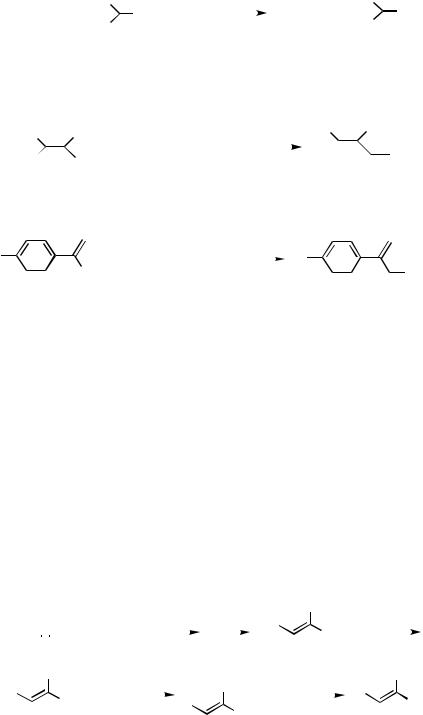
674 III Pd-CATALYZED CROSS-COUPLING |
|
|
|
|
|
|
|
|
|
|
||||||||||||
|
|
|
|
|
|
|
|
|
Y |
|
|
cat. |
|
|
|
|
|
|
|
|
|
Y |
|
|
|
|
|
Y |
|
|
|
|
PdLn |
|
|
|
|
|
Y |
|
or |
||||
|
|
|
|
|
|
|
|
or |
M + R |
|
X |
|
|
|
|
|
|
|
|
|
R |
|
|
|
C |
|
C |
|
M |
Z |
|
|
|
|
|
C |
|
C |
|
R |
Z |
||||
|
|
|
|
|
|
|
|
|
|
|
||||||||||||
(Z may or may not be the same as Y)
Scheme 1
R |
|
SiMe3 |
|
|
|
|
|
R |
|
|
|
SiMe3 |
||||
|
H2C |
|
CHBr |
Pd(PPh3)4 |
|
|
|
|
|
|
||||||
|
|
|
|
|
|
|
|
|||||||||
|
|
|
|
+ |
|
|
|
|
|
|
|
|
|
|
||
|
|
|
|
|
|
|
|
|
|
|
||||||
|
|
|
|
|
THF |
|
|
|
|
|
|
|||||
H |
|
Al(i-Bu)2 |
|
|
|
68−74% |
||||||||||
|
|
|
|
|
|
|
|
|
|
|
||||||
|
|
|
|
|
|
|
Scheme 2 |
|
|
|
|
|
|
|||
Br |
|
|
(Me3SiCH2)3Al, Pd(PPh3)4 cat. |
|
|
|
|
|
|
|||||||
|
|
|
|
|
|
|
Br |
|
|
|
|
|
|
|||
|
|
|
|
|
|
|
|
|
|
|
|
|
||||
|
|
|
|
OSO2CF3 |
ClCH2CH2Cl/C6H6, r.t., 2.2 h |
|
|
|
|
|
SiMe |
|||||
|
|
|
|
|
|
|
|
|
||||||||
|
|
|
|
|
|
|
|
|
|
|
3 |
|||||
84%
Scheme 3
C. ORGANOBORON COMPOUNDS
Suzuki and co-workers have reported the reaction of diisopropyl -bromoalkenyl- boronates, readily obtained from hydroboration of 1-bromoalkynes and followed by the addition of organolithium, with base to give 1-organo-1-alkenylboronates. The [Pd(PPh3)4]-catalyzed cross-coupling reaction with organic halides proceeds smoothly in the presence of base to form highly stereoand regiospecific trisubstituted alkenes (Scheme 4).[4],[5] Likewise, Waas and co-workers have reported the conversion of - iodoalkenylboronates, readily prepared by the hydroboration of 1-iodoalkynes, to 1,1- bimetallics of boron and zinc or copper, which react with a wide range of electrophiles to afford polyfunctional boronic esters. After hydrogen peroxide oxidation, polyfunctional ketones were produced in good to excellent yields (Scheme 5).[6] Note that - iodoalkenylboronates may undergo cross-coupling with organozinc compounds in the
|
|
|
|
|
|
|
|
|
|
|
|
|
|
|
Br |
|
|
|
||
R1 |
|
C |
|
C |
|
Br + HBBr2:SMe2 |
|
|
i-PrOH |
|
R1 |
|
B(OPr-i)2 |
R2Li |
|
|||||
|
|
|
|
|
|
|
|
|
|
R3 |
||||||||||
|
|
|
|
|
|
|
|
|||||||||||||
|
|
|
Br |
|
|
|
|
|
|
3 |
|
|
|
|||||||
|
|
|
|
|
|
|
base |
|
|
B(OPr-i)2 |
|
X |
|
|
|
|
||||
R1 |
|
|
|
|
|
|
|
|
R |
R1 |
||||||||||
|
|
|
|
|
B(OPr-i)2R2 |
R1 |
|
|
Pd(PPh3)4 cat. |
|
R2 |
|||||||||
|
|
|
|
|
|
|
|
|
|
|
R2 |
|
|
aq. KOH |
61−94% |
|||||
|
|
|
|
|
|
|
|
|
|
|
|
|
|
|
|
|
|
|||
Scheme 4
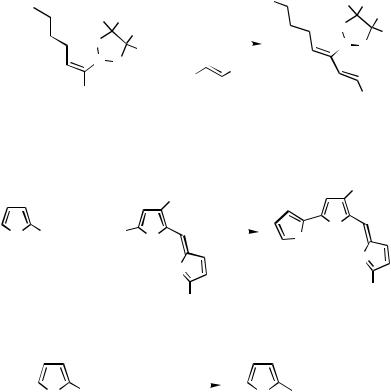
III.2.13.2 OTHER -HETERO-SUBSTITUTED ORGANOMETALS IN CROSS-COUPLING |
675 |
presence of Pd catalyst to give 1-organo-1-alkenylboronic esters or -organoalkenyl- boronates.[7]
The Suzuki coupling methodology has widely been used in the preparation of pyrrole derivatives. Thus, the immunosupressive agent undecylprodigiosine can be prepared by the [Pd(PPh3)4]-catalyzed cross-coupling reaction of two pyrrole rings (Scheme 6).[8] The preparation of 2-aryl-1-(phenylsulfonyl)pyrroles can also be realized by cross-coupling of 1-(phenylsulfonyl)pyrrole-2-boronic acid and aryl bromides or iodides (Scheme 7).[9] Similarly, Suzuki coupling of 2-thienylboronic acid with either aryl halides or triflate could give the corresponding thienyl derivatives.[10]–[18] Likewise, 2-furanylboronic acid could cross-coupling with either aryl or vinyl halides or triflate via the Suzuki reaction to give the corresponding furanyl derivatives.[11],[19] – [25] Triethyl(1-methylindol-2-yl)borate has been used for the Pd-catalyzed tandem cyclization and cross-coupling reaction with acetylenic or vinylic aryl halides to form ellipticine analogs (Scheme 8).[26],[27]
Me |
|
|
|
|
|
|
|
|
|
|
|
Me |
Me |
Me |
|||||
Me |
Me |
|
|
|
|
|
|
|
|
|
|
|
|
Me |
|||||
|
|
|
|
|
|
1. Zn, DMA |
|
|
|
|
|||||||||
|
|
|
|
|
|
|
|
|
O |
|
|||||||||
|
|
|
|
|
|
Me |
|
|
|
|
|
||||||||
|
|
|
|
O |
|
|
2. CuCN 2 LiCl |
|
|
|
Me |
||||||||
|
|
|
|
|
|
|
|
|
|
|
B |
||||||||
|
|
|
|
|
|
Me |
|
|
|
|
|
|
|
|
|
|
O |
||
|
|
|
|
|
|
|
3. Pd(dba)2 cat. |
|
|
|
|||||||||
|
|
|
|
B |
O |
|
|
|
|
|
|
|
|||||||
|
|
|
|
|
|
|
|
|
|
|
|
||||||||
|
|
|
|
|
|
|
|
|
|
Hex |
|
|
|
|
|
||||
|
|
|
|
|
|
|
|
|
I |
|
|
|
|
|
|
||||
|
|
|
|
|
|
|
|
|
|
|
|
|
|
|
|
|
|
||
|
|
|
|
I |
|
|
|
|
|
|
|
|
|
|
|
|
|
|
Hex |
|
|
|
|
|
|
|
|
|
|
|
|
|
|
|
|
|
|
|
|
|
|
|
|
|
|
|
|
|
|
|
|
|
|
|
|
|
|
77% |
|
|
|
|
|
|
|
|
|
|
Scheme 5 |
|
|
|
|
|
|||||
|
|
|
|
|
|
|
|
|
OMe |
|
|
|
|
|
|
|
|
OMe |
|
|
|
|
|
|
|
|
|
|
|
|
|
|
|
|
|
|
|
||
|
|
|
|
|
|
|
|
|
|
|
Pd(PPh3)4 |
|
|
|
|
|
|||
N B(OH)2 |
+ |
TfO |
|
|
|
|
|
|
cat. |
|
|
|
|
N |
|
||||
|
N |
|
|
|
|
K2CO3 |
|
|
|
N |
|
||||||||
|
|
|
|
|
|
|
|
|
|
|
|
|
|
|
|||||
Boc |
|
|
|
|
|
|
|
|
|
|
|
|
|
|
|
N |
|||
|
|
|
|
|
|
|
|
|
N |
|
|
|
|
|
|
|
|
||
|
|
|
|
|
|
|
|
|
|
|
|
|
|
|
|
|
|
||
|
|
|
|
|
|
|
|
|
C11H23-n |
|
|
|
|
C11H23-n |
|||||
|
|
|
|
|
|
|
|
|
|
|
|
73% |
|
||||||
|
|
|
|
|
|
|
|
|
|
|
|
|
|
|
|
|
|
|
|
|
|
|
|
|
|
|
|
|
Scheme 6 |
|
|
|
|
|
|||||
|
|
|
|
|
|
|
Pd(PPh3)4 cat. |
|
|
|
|
|
|
|
(39−91%) |
||||
|
|
|
|
|
|
|
|
|
|
|
|
|
|
|
|
|
|
||
|
N |
B(OH)2 |
|
|
Ar-X |
|
|
|
|
N |
Ar |
|
|||||||
|
|
|
SO2Ph |
|
X = Br or I |
|
|
|
|
|
|
SO2Ph |
|
||||||
|
|
|
|
|
|
|
Ar = Ph, 1-Napth, |
|
|||||||||||
|
|
|
|
|
|
|
|
|
|
|
|
4-NO2Ph, 4-AcPh, |
|
||||||
|
|
|
|
|
|
|
|
|
|
|
|
4-MeOPh |
|
|
|||||
Scheme 7
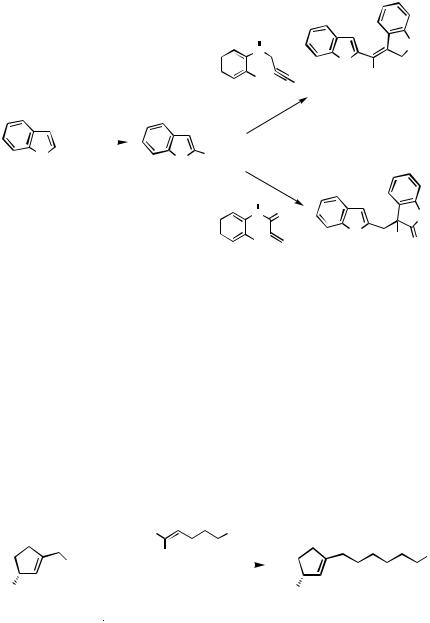
676 |
III Pd-CATALYZED CROSS-COUPLING |
COPh
|
|
|
|
|
|
|
|
|
N |
|
N |
|
N |
|
COPh |
|||||
|
|
|
|
|
|
|
|
|
|
|
|
|||||||||
|
|
|
|
|
|
|
|
|
|
|
|
|
|
|
|
|||||
|
|
|
|
|
|
|
|
|
|
|
|
R |
|
|
|
|
|
|||
|
|
|
|
|
|
|
|
|
|
|
|
|
|
|
|
|
||||
|
|
|
|
|
|
|
|
|
|
|
|
|
|
|
|
|
|
|
|
|
|
|
|
|
|
|
|
|
|
I |
R |
Me |
|
|
|
|
|
||||
|
|
|
|
|
|
|
|
|
|
|
|
|
|
|
||||||
|
|
|
|
|
|
|
|
|
Pd(OAc)2 |
|
|
|
|
|
|
|
|
|
||
|
|
|
|
|
|
|
|
|
|
|
R = Me, SiMe3 |
|||||||||
|
1. t-BuLi, THF |
|
|
|
|
|
cat. |
|
|
|||||||||||
|
|
|
|
Li+ |
|
|
|
53−78% |
|
|
|
|
|
|||||||
|
2. BEt3 |
|
|
|
|
|
|
|
|
|
|
|||||||||
|
|
|
|
|
|
|
− |
|
|
|
|
|
|
|
|
|
|
|
||
|
|
|
|
|
|
|
|
|
|
|
|
|
|
|
|
|
||||
N |
|
N |
BEt3 |
Pd(OAc)2 |
|
|
|
|
|
|
|
|
|
|||||||
|
|
|
|
|
|
|
|
|
|
|
|
|
|
|
|
|
|
|||
Me |
|
Me |
|
|
|
|
|
|
|
|
|
|
||||||||
|
|
|
|
|
|
|
|
cat. |
|
|
|
|
|
|
|
|
|
|
||
|
|
|
|
|
|
|
|
|
|
|
|
|
|
|
|
|
|
|
|
|
|
|
|
|
|
|
|
|
|
Me |
|
|
|
|
|
|
|
|
|
|
|
|
|
|
|
|
|
|
|
|
N O |
|
|
N |
|
|
N |
|
Me |
|||
|
|
|
|
|
|
|
|
|
|
|
|
|
|
|||||||
|
|
|
|
|
|
|
|
|
I |
|
|
|
|
Me O |
||||||
|
|
|
|
|
|
|
|
|
|
|
|
|||||||||
|
|
|
|
|
|
|
|
|
|
|
|
|||||||||
|
|
|
|
|
|
|
|
|
|
|
|
|
|
|
||||||
|
|
|
|
|
|
|
|
|
Me |
|
|
Me |
|
|
|
|
|
|
||
|
|
|
|
|
|
|
|
|
|
|
|
|
|
|
75% |
|
|
|
|
|
|
|
|
|
|
|
|
Scheme 8 |
|
|
|
|
|
|
|
|
|
|
|||
The [Pd(PPh3)4]-catalyzed cross-coupling reaction of -silylalkenylborane with 2-bromomethyl-4-siloxycyclopent-2-enone followed by the conversion to an epoxy and keto group could form a key component for the preparation of 6-keto-prostaglandins (Scheme 9).[28] Suzuki coupling of aryl or vinyl bromides with -silylalkenylborane under basic conditions or -silylalkenylborate could provide the corresponding silylated styrenes and 1,3-dienes with highly stereoselectivity ( 98%).[2],[29] Soderquist and co-workers have reported that allyl, benzyl, and propargyl silanes can be prepared via Suzuki reaction of vinyl, alkynyl, and aryl bromides with the air-stable organoborane, 10-trimethylsilylmethyl-9-oxa-10-borabicyclo[3.3.2]decane, in excellent yields.[30]
|
O |
1. (o-C6H11)2B |
CO2Me |
O |
|||||||
|
|
|
Br |
TMS |
|
|
|
|
|
|
CO2Me |
|
|
|
|
|
|
|
|||||
|
|
|
cat. Pd(PPh3)4-NaOH |
|
|
|
|
|
|
|
|
TBSO |
|
|
|
|
|
O |
|||||
|
|
|
|
|
|
||||||
|
|
|
|
TBSO |
|||||||
|
|
|
2. m-CPBA/CH2Cl2 |
|
|
57% |
|||||
|
|
|
3. BF3 OEt2/MeOH |
|
|
|
|
|
|
|
|
Scheme 9
D. ORGANOCOPPER COMPOUNDS
Kalinin and Min have reported the synthesis of aryland vinyl-sydnones from the [Pd(PPh3)4]-catalyzed cross-coupling reaction of 4-copper-3-phenylsydnone with aryl and vinyl halides (Scheme 10).[31]

|
|
|
III.2.13.2 |
OTHER -HETERO-SUBSTITUTED ORGANOMETALS IN CROSS-COUPLING 677 |
|||||||||||||||
|
|
|
|
|
|
|
|
|
|
|
|
|
|
|
Ph |
|
|
|
|
|
|
|
|
|
|
|
|
|
|
|
|
|
|
|
|
|
|
|
|
|
|
|
|
|
|
|
|
|
|
|
|
N |
N |
CH |
|
CHPh |
|||
|
|
|
|
|
|
|
|
|
|
|
|
|
|
|
|
||||
|
|
|
|
|
|
|
|
|
|
|
|
|
|
|
|
||||
|
|
|
|
|
|
|
|
|
|
|
|
|
|
|
|
|
|
||
|
|
|
|
|
|
|
|
Pd(PPh3)4 |
|
|
O |
|
|
|
|||||
|
|
|
|
|
|
|
|
cat. |
|
|
|
|
|
|
O − |
||||
|
Ph |
|
|
|
Ph |
|
BrCH |
|
CHPh |
|
|
|
|
||||||
|
|
1. BuLi/THF |
|
|
|
|
86% |
|
|
||||||||||
|
|
|
|
|
|
|
|
|
|
|
|
||||||||
N |
N |
Li |
−78 °C |
N |
N |
Cu |
|
|
|
|
|
|
|
|
|
||||
|
|
|
|
|
|
|
|
|
|
|
|
|
|||||||
|
|
|
2. CuBr |
|
|
|
|
|
|
|
|
|
|
|
|
|
|
||
O |
|
|
|
O |
|
|
|
|
|
|
|
|
|
|
|
|
|
|
|
|
|
O− |
|
|
|
O− |
|
|
|
|
|
|
|
|
|
||||
|
|
|
|
|
|
|
|
|
|
Ph |
|
|
|
||||||
|
|
|
|
|
|
|
|
Pd(PPh3)4 |
|
|
|
|
|
R |
|||||
|
|
|
|
|
|
|
|
|
|
|
|
|
|
|
|
||||
|
|
|
|
|
|
|
|
cat. |
|
N |
N |
|
|
|
|||||
|
|
|
|
|
|
|
|
|
|
|
|
|
|
|
|||||
|
|
|
|
|
|
|
|
|
|
|
|
|
|
|
|
|
|
||
|
|
|
|
|
|
|
|
I |
|
R |
O |
|
|
|
O− |
||||
|
|
|
|
|
|
|
|
|
|
|
|
|
|
|
|
|
|||
|
|
|
|
|
|
|
|
R = H, NO2, OMe |
|
|
90−92% |
||||||||
Scheme 10
E. ORGANOLITHIUM COMPOUNDS
Araki and co-workers have reported the [Pd(PPh3)4]-catalyzed cross-coupling reaction of isoprene bromohydrin with heteroaromatic organolithium reagents in good yields without rearrangement (Scheme 11).[32] Pelter and co-workers have reported that the [Pd(PPh3)4]- catalyzed cross-coupling reactions of 2-lithiofuran with allyl or benzyl bromides work well, but fail with aryl bromide.[33]
OH |
ArLi, Pd(PPh3)4 cat. |
OH |
|
Br |
Ar |
||
|
|||
|
|||
Me |
Z |
Me |
|
|
Ar = |
|
60−92%
Z = O, S, NMe
Scheme 11
F. ORGANOMAGNESIUM COMPOUNDS
Negishi and co-workers have reported the [Pd(PPh3)4]-catalyzed cross-coupling reaction of trimethylsilylmethylmagnesium chloride with alkenyl iodides to form allylsilanes in excellent yields and in a highly stereoand regioselective manner (Scheme 12).[34],[35] Sugihara and Ogasawara have reported the [PdCl2(PPh3)2]-catalyzed cross-coupling reaction of optically active 2-chlorovinylcarbinols with trimethylsilylmethylmagnesium chloride to form certain optically active allyl alcohols.[36] Alternatively, Hevesi and coworkers have reported the [PdCl2(PPh3)2]-catalyzed cross-coupling reaction of vinyl selenides with trimethylsilylmethylmagnesium chloride to form allylsilanes.[37] Minato and co-workers have reported the [PdCl2(dppb)]- or [PdCl2(dppf)]-catalyzed cross-coupling reaction of 1-methyl-2-pyrrolylmagnesium bromide with aryl and heteroaryl halides to
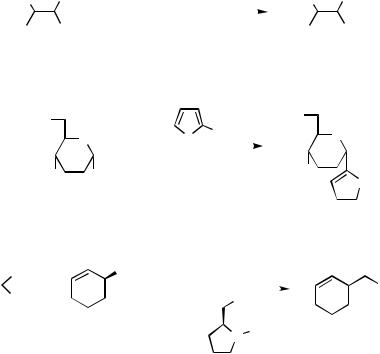
678 |
III Pd-CATALYZED CROSS-COUPLING |
give the corresponding 2-substituted pyrroles in good to excellent yields.[38],[39] Likewise, 2-thienylmagnesium bromide could be coupled with p-tert-butylphenyl -O- 2-glycopy- ranoside to form C- -aryl- 2-glycopyranosides in the presence of PdCl2(dppf) catalyst (Scheme 13).[39],[40] The [PdCl2(dppb)]-catalyzed cross-coupling reactions of - silylvinylmagnesium bromide with heteroaryl bromides have also been reported.[7] Buono and co-workers have reported the use of PdCl2(MeCN)2 catalyst and chiral AMPP (aminophosphine phosphinite) ligands[41] in the allylation of 1-trimethylsilylvinylmagne- sium bromide with 3-cyclohexenyl acetate to give a versatile synthon, 3-(1-trimethylsi- lylvinyl)cyclohexene, in high yields and with ee up to 33% (Scheme 14).[42]
n-C4H9 |
H |
|
|
|
Pd(PPh3)4 cat. |
n-C4H9 |
|
|
H |
|||||||||||
|
|
|
|
|
+ ClMgCH2SiMe3 |
|
|
|
|
|
|
|
|
|
|
|
||||
|
|
|
|
|
|
|
|
|
|
|
|
|
|
|||||||
|
|
|
|
|
THF |
|
|
|
|
|
|
|
||||||||
|
Me |
I |
|
|
|
|
Me |
|
|
CH2SiMe3 |
||||||||||
|
|
|
|
|
|
|
|
|
|
|||||||||||
|
|
|
|
|
|
|
|
|
|
|
|
|
|
|
85% |
|
|
|
||
|
|
|
|
|
|
|
|
|
Scheme 12 |
|
|
|
|
|
|
|
||||
|
BnO |
|
|
|
|
|
|
|
|
|
|
BnO |
|
|
|
|
|
|
||
|
|
|
|
|
|
|
|
MgBr |
|
|
|
|
|
|
|
|||||
|
|
|
|
|
O |
|
|
S |
|
O |
||||||||||
|
|
|
|
|
|
|
|
|
|
|
||||||||||
|
|
|
|
|
|
|
|
|
PdCl2(dppf) cat. |
|
|
|
|
|
|
|
||||
|
|
BnO |
|
|
|
OC6H4-4-But |
|
|
81% |
|
|
BnO |
|
|
|
S |
||||
|
|
|
|
|
|
|
|
|
|
|
||||||||||
|
|
|
|
|
|
|
|
|
|
|
|
|
|
|
|
|
|
|||
|
|
|
|
|
|
|
|
|
Scheme 13 |
|
|
|
|
|
|
|
||||
|
|
|
|
|
|
|
|
|
|
|
|
|
|
|
|
|||||
|
|
|
|
|
|
|
OAc |
|
|
|
|
|
|
|
|
|
|
CH2 |
||
|
SiMe3 |
|
|
|
PdCl2(ProliNOP) cat. |
|
|
|
|
|
|
|
||||||||
|
|
|
|
|
|
|
|
|
|
|
|
SiMe3 |
||||||||
|
+ |
|
|
|
|
|
|
|
|
|
|
|
|
|
|
|
|
|||
|
|
|
|
|
|
|
|
|
|
|
|
|
|
|
||||||
|
|
|
|
|
|
|
|
|
|
|
|
|
|
|
|
|
||||
|
MgBr |
|
|
|
|
|
|
|
OPPh2 |
|
|
|
|
|
|
|
||||
|
|
|
|
|
|
|
ProliNOP: |
S |
|
|
|
|
|
|
|
|||||
|
|
|
|
|
|
|
N PPh2 |
|
80% (30% ee) |
|||||||||||
Scheme 14
G. ORGANOMERCURY COMPOUNDS
Bumagin and co-workers have reported the ArPdI(PPh3)2-catalyzed cross-coupling of 2- furanyl or 2- thienylmercurials with aromatic halides in the presence of iodide ion to give coupling products in high yields. In the case of acyl halides, unsymmetrical diaryl ketones could be obtained in good yields (Scheme 15).[43],[44]
H. ORGANOTIN COMPOUNDS
-Hetero-substituted organotin compounds (Scheme 16) have been used extensively in the Pd-catalyzed cross-coupling reaction with various electrophiles, since the tin

III.2.13.2 OTHER -HETERO-SUBSTITUTED ORGANOMETALS IN CROSS-COUPLING |
679 |
+ 2 × O2N |
|
|
p-NO2C6H4PdI(PPh3)4 cat. |
|
|
|
|
S |
|||||
|
|
|
|
|
|
||||||||
|
I |
|
|
|
|
2 × O2N |
|
||||||
|
2 equiv NaI, DMF |
|
|||||||||||
)2 Hg |
|
|
|
|
|
|
|
|
|||||
|
|
|
|
|
|
|
|
|
|
|
|
||
S |
|
|
|
|
|
|
|
|
|
|
|
|
|
|
|
|
|
|
|
|
|
94% |
|
||||
|
|
|
|
p-NO2C6H4PdI(PPh3)4 |
|
|
|
|
O |
||||
+ 2 × O2N |
|
COCl |
cat. |
|
2 × O2N |
||||||||
|
2 equiv NaI, DMF |
||||||||||||
)2 Hg |
|
|
|
|
|
|
|
S |
|||||
S |
|
|
|
|
|
|
|
|
|
|
|||
100%
Scheme 15
derivatives may tolerate a variety of functional groups both in the organometallic reagent and in heterocyclic halides. Matthews and co-workers have reported the use of (1-fluorovinyl) tributyltin as a synthetic equivalent for the 1-fluoroethene anion in the Pdcatalyzed cross-coupling with aryl iodide, aryl triflate, or acid chloride to form the corresponding alkenyl fluoride derivatives.[45],[46] Shi and co-workers have reported the addition of copper(I) iodide as a cocatalyst in the [Pd(PPh3)4]-catalyzed cross-coupling reaction of (1-fluorovinyl)tributyltin reagent to give better yields.[47] The cross-coupling of hexabutyldistannane with (4-bromophenyl)methylsulfone in the presence of both Pd(OAc)2 and Pd(PPh3)4 catalysts could give methyl[4-(tributylstannyl)phenyl]sul- fone.[21] Likewise, hexamethyldistannane can couple with triflated oxazole by the aid of Pd catalyst to give 4-trimethylstannyloxazole.[48]
The Pd-catalyzed cross-coupling of 2-thienyl-, 2-pyrrolyl-, 2-furyl-, and 2- pyridyltin reagents with various organic halides or triflates, such as aryl, heteroaryl, allyl, and alkenyl halides, have been extensively studied and reported in the litera- ture.[49]–[98] The intact functional groups include aldehyde,[49],[50] ester,[49],[50] alcohol,[49] amide,[50],[51] amino,[52],[53] nitro group,[54] and uracil moiety.[55],[56] Gronowitz and co-workers have reported the synthesis of dithienopyridines and other fused heterocycles through Pd-catalyzed cross-coupling of 2-thienyltin reagent with N-(halo- heteroaryl)carbamates (Scheme 17).[57]–[61] Kang and co-workers have reported the Pd-catalyzed cross-coupling of 2-thienyl and 2-furyltin compounds with iodanes[74] or hypervalent iodonium salts[75] (Scheme 18). Liebeskind and Wang have reported the construction of substituted benzoand dibenzofurans or thiophenes by the Pdcatalyzed cross-coupling of 2-furyl- or 2-thienyltin reagent with 4-chloro-2,3- disubstituted-2-cyclobutenones and followed by thermolysis at 100 °C (Scheme 19).[80] Under the same conditions, both 2-(tri-n-butylstannyl)benzofuran and 2-(tri-n- butylstannyl)thiophene react with 4-chloro-2,3-disubstituted-2-cyclobutenones to form dibenzoheteroaryls.[80] Similarly, 2-benzofuranyl-, 2-benzothiophenenyl-, or 2- indolytin reagents may couple with aryl, heteroaryl, alkenyl, alkynyl, or alkyl halides in the presence of Pd catalyst to give the corresponding coupled products in good yields and in a stereoselective manner.[80],[81],[84],[99]–[105] Intramolecular cyclization based on the Pd-catalyzed cross-coupling reaction of 2-indolyltin and vinyl or benzyl bromide could give high yields of the corresponding sevenand nine-membered ring (Scheme 20).[103] 2-Selenienyltin compound also has been used in the Pd-catalyzed cross-coupling reaction with iodopyrimidine.[83] Alkenyltin containing -alkylthio or-alkyloxy substituents reacts readily with chloropurines and aryl halides in the
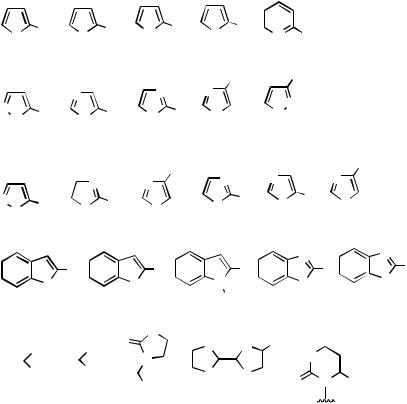
680 |
III Pd-CATALYZED CROSS-COUPLING |
presence of Pd catalyst to produce alkenylated purines and benzenes, respec- tively.[86]–[88],[92],[106] Liebeskind and Wang have reported the synthesis of substituted 2-pyrones by carbonylative cross-coupling and thermolysis of 4-halocy- clobutenones with 2-ethoxyvinyl-, 2-furyl-, and 2-thienyltin reagents (Scheme 21).[89] Optically active ene carbamates were -lithiated by lithium tetramethylpiperidide in the presence of trialkylstannyl chlorides to produce -stannylated compounds.[107] These stannylated compounds underwent facile Pd-catalyzed cross-coupling with acid chlorides to produce -keto ene carbamates in good yields (Scheme 22). The Pdcatalyzed cross-coupling of stannylated 2- and 4-oxazole,[48],[108] 5-isoxazole,[93],[98] 2- benzoxazole,[109] 2-, 4-, and 5-thiazole,[82],[85],[93],[110] 2-benzothiazole,[91],[109] 2-, 4-, and
5-imidazole,[85],[90],[93],[111]–[113] 3-pyrazole,[114]–[116] 2-oxazoline,[117],[118] and 6-uridine[119]
with various organic electrophiles have been reported in the literature to give the corresponding regioand stereoselective products. Iyoda and co-workers have reported the Pdcatalyzed cross-coupling of (trialkylstannyl)tetrathiafulvalene with aryl, naphthyl, or 1,6-methano[10]annulene halides to give the corresponding tetrathiafulvalene-substituted aryl, naphthalene, and 1,6-methano[10]annulene derivatives.[120],[121]
α-Hetero-substituted organotin compounds |
|
|
|
|
|
|
|
|
|
|||||||||||||||||
|
|
S |
O |
|
|
N |
|
Se |
|
|
N |
|
|
|
|
|
||||||||||
|
|
|
|
|
|
|
|
|
|
|
|
|||||||||||||||
|
|
|
|
|
|
|
|
|
|
|
|
|||||||||||||||
|
|
|
|
|
|
|
|
|
|
|
|
|
|
|
|
|
|
|
|
|
|
|
|
|
|
|
|
|
|
|
|
|
|
|
|
|
|
R |
|
|
|
|
|
|
|
|
|
|
|
|
|
||
|
|
|
|
|
N |
|
|
|
|
N |
|
N |
|
|
|
N |
|
|
|
|
|
|||||
N |
|
|
|
|
|
|
|
|
|
|
|
|
|
|
|
|
|
|
|
|
|
|||||
|
|
|
|
|
|
N |
|
N |
|
|
N |
|
|
|
|
|
||||||||||
|
|
N |
N |
|
|
|
|
|
|
|
|
|
|
|||||||||||||
|
|
|
|
|
|
|
|
|
|
|
|
|
|
|
|
|
||||||||||
|
|
|
|
|
|
|
|
|
|
|
|
|
|
|
|
|
|
|
R |
|
|
|
|
|
||
|
|
R |
R |
|
|
R |
|
R |
|
|
|
|
|
|
|
|||||||||||
|
|
|
|
|
|
|
N |
|
|
N |
|
|
|
N |
|
|
N |
|
|
N |
||||||
|
|
|
|
|
|
|
|
|
|
|
|
|
|
|
|
|
|
|
|
|
|
|||||
N |
|
O |
|
|
|
|
O |
|
S |
|
|
|
S |
|
|
|
|
S |
||||||||
|
|
O |
|
|
|
|
|
|
|
|
|
|
|
|
|
|
|
|
|
|
||||||
|
|
|
|
|
|
|
|
|
|
|
|
|
|
|
|
|
|
|
|
|
N |
|
|
|
|
N |
|
|
|
|
S |
|
|
|
|
|
O |
|
|
N |
|
|
|
O |
|
|
|
|
S |
||||
|
|
|
|
|
|
|
|
|
|
|
|
|
|
|
|
|
|
|||||||||
|
|
|
|
|
|
|
|
|
|
|
|
|
|
|
|
|
|
|||||||||
|
|
|
|
|
|
|
|
|
|
|
|
|
|
|
|
|
R |
|
|
|
|
|
|
|
|
|
|
|
|
|
|
|
|
|
|
|
|
O |
|
|
|
|
|
|
|
|
O |
||||||
|
|
|
|
OR |
|
|
SR |
O |
|
S |
S |
|
|
|
|
|
||||||||||
|
|
|
|
|
|
|
|
|
|
|
|
|
|
|
|
|
||||||||||
|
|
|
|
|
|
|
|
|
|
|
N |
|
|
|
|
|
|
|
N |
|
|
|
|
|
||
|
|
|
|
|
|
|
|
|
|
|
|
|
|
|
S |
S |
|
|
|
|
|
|||||
|
|
|
|
|
|
|
|
|
|
|
|
|
|
|
N |
|||||||||||
|
|
|
|
|
|
|
|
|
|
|
|
|
|
|
||||||||||||
|
|
|
|
|
|
|
|
|
|
|
|
|
|
|
|
|
|
|
|
|
O |
|||||
Scheme 16
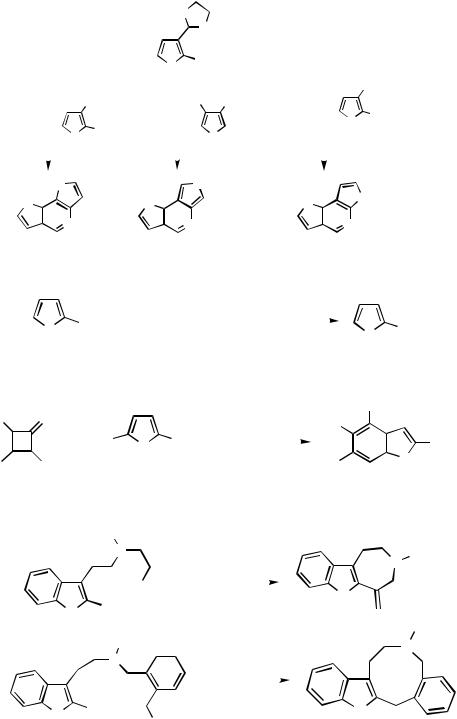
|
III.2.13.2 OTHER -HETERO-SUBSTITUTED ORGANOMETALS IN CROSS-COUPLING |
681 |
|||||||||||||||||||||||||||||
|
|
|
|
|
|
|
|
|
|
|
|
|
|
O |
|
|
|
|
|
|
|
|
|
|
|
|
|
|
|||
|
|
|
|
|
|
|
|
|
|
|
|
|
|
|
|
O |
|
|
|
|
|
|
|
|
|
|
|
|
|
|
|
|
|
|
|
|
|
|
|
|
|
|
S |
|
SnMe3 |
|
|
|
|
|
|
|
|
|
|
|
|
|
|||||
|
|
|
|
|
|
|
|
|
|
|
|
|
|
|
|
|
|
|
|
|
|
|
|
|
|
|
|
I |
|
|
|
|
|
|
|
|
|
|
|
|
|
|
|
|
|
|
|
|
|
|
|
|
|
|
|
|
|
|
|
|
|
||
|
|
|
|
|
|
|
NHCO2Bu-t |
|
|
|
|
Br |
NHCO2Bu-t |
1. |
|
|
|
|
|
|
|||||||||||
|
|
|
1. |
|
|
|
|
|
|
|
|
|
1. |
|
|
|
|
|
|
|
|
S |
|
NHCO2Bu-t |
|
||||||
|
|
|
|
|
|
|
|
|
|
|
|
|
|
|
|
|
|
|
|
|
|
|
|
||||||||
|
|
|
S Br |
|
|
|
|
|
|
|
|
|
|
|
|
|
|
|
|
|
|
|
|
||||||||
|
|
|
|
|
|
,Pd cat./DMF, |
|
|
S |
|
,Pd cat./DMF, |
|
Pd cat./DMF, |
|
|
||||||||||||||||
|
|
|
|
|
|
|
|
100 −120 °C |
|
|
|
|
|
|
|
|
100 −120 °C |
|
100 −120 °C |
|
|
||||||||||
|
|
|
2. 2 N HCl |
|
|
|
|
|
|
2. 2 N HCl |
|
|
|
|
|
2. 2 N HCl |
|
|
|||||||||||||
|
|
|
|
|
|
|
|
|
|
|
|
|
|
|
|
||||||||||||||||
|
|
|
|
S |
|
|
|
|
|
|
|
|
|
|
S |
|
|
|
|
|
|
|
|
|
|
|
|
|
|
||
|
S |
|
|
|
S |
|
|
|
|
|
|
|
|
|
|
|
|
S |
|
|
|
|
S |
|
|
||||||
|
|
|
|
|
|
|
|
|
|
|
|
|
|
|
|
|
|
|
|
|
|
|
|
||||||||
|
|
|
|
|
N |
|
|
|
|
|
|
|
N |
|
|
|
|
|
|
|
|
N |
|
|
|
|
|
||||
|
|
|
|
|
|
|
|
|
|
|
|
|
|
|
|
|
|
|
|
|
|
|
|||||||||
|
43% |
|
|
|
|
|
|
63% |
|
|
|
|
|
|
|
|
27% |
|
|
|
|
|
|||||||||
|
|
|
|
|
|
|
|
|
|
|
|
|
|
|
Scheme 17 |
|
|
|
|
|
|
|
|
|
|
|
|
|
|||
|
|
|
|
|
|
|
|
+ PhI(OH)OTs or Ph2I+BF4− |
|
|
PdCl2 cat. |
|
|
|
|
|
|
|
|
||||||||||||
|
|
Z |
|
|
SnBu3 |
|
|
|
|
|
|
|
|
|
|
|
Ph |
|
|||||||||||||
|
|
|
|
|
|
MeCN/H2O |
|
|
|
|
Z |
|
|||||||||||||||||||
|
|
|
|
|
|
|
|
|
|
|
|
|
|
|
|
|
|
|
|
|
|
||||||||||
|
|
|
|
|
|
|
|
|
|
|
|
|
|
|
|
|
|
|
|
|
|
|
|
|
|
|
|||||
|
Z = O, S |
|
|
|
|
|
|
|
|
|
|
|
|
|
|
|
|
|
|
|
|
87−95% |
|
|
|||||||
|
|
|
|
|
|
|
|
|
|
|
|
|
|
|
Scheme 18 |
|
|
|
|
|
|
|
|
|
|
||||||
|
|
|
|
|
|
|
|
|
|
|
|
|
|
|
|
|
|
|
|
|
|
|
|
|
|
|
|
||||
|
|
|
|
|
|
|
|
|
|
|
|
|
|
|
|
|
|
|
|
|
|
|
|
|
|
|
|
OAc |
|
|
|
Et |
O |
|
|
|
|
|
|
|
|
|
|
|
|
|
|
|
|
|
|
|
Et |
|
|
|
|
|
|||||
|
|
|
|
|
|
|
|
|
|
|
|
|
|
|
|
|
1. PdCl2(PhCN)2 cat. |
|
|
|
|
|
|||||||||
|
+ |
|
n-Bu3Sn |
Z |
|
|
TMS |
|
|
|
|
|
|
|
TMS |
||||||||||||||||
|
|
|
|
|
|
|
|
|
|
|
|||||||||||||||||||||
|
|
|
|
|
|
|
|
|
|
|
|
|
|
|
|
|
|
||||||||||||||
|
tris-2-furylphosphine |
|
|
|
|
|
|
Z |
|||||||||||||||||||||||
|
|
|
|
|
|
|
|
|
|
|
|
|
|
|
|
|
|
|
|
|
|
|
|
||||||||
Et |
Cl |
|
|
|
|
|
|
|
|
|
|
|
|
dioxane, 50−100 °C |
Et |
|
|
|
|
||||||||||||
|
|
|
|
|
|
|
|
Z = O, S |
|
|
|
|
|
|
2. Ac2O/pyridine |
|
|
|
58−71% |
|
|
||||||||||
|
|
|
|
|
|
|
|
|
|
|
|
|
|
|
|
|
|
|
|
|
|
|
|
|
|
||||||
|
|
|
|
|
|
|
|
|
|
|
|
|
|
|
Scheme 19 |
|
|
|
|
|
|
|
|
|
|
|
|
|
|||
|
|
|
|
|
|
|
Ts |
|
|
|
|
|
|
|
|
|
|
|
|
|
|
|
|
|
|
|
|
|
|||
|
|
|
|
|
|
|
|
N |
|
|
|
|
|
|
|
|
|
|
|
|
|
|
|
|
|
|
N |
Ts |
|
||
|
|
|
|
|
|
|
|
|
|
|
|
|
|
|
|
|
|
|
|
|
|
|
|
|
|
|
|
|
|
||
|
|
|
|
|
|
|
|
|
|
|
|
|
|
|
Pd2(dba)3 CHCl3 |
|
|
|
|
|
|
|
|||||||||
|
|
|
|
|
|
|
|
Br |
|
|
|
|
|
|
|
|
|
|
|
|
|||||||||||
|
|
|
|
|
|
|
|
|
|
|
|
|
|
|
|
|
|
|
|
|
|
|
|
|
|
|
|
|
|||
|
|
|
|
|
|
|
|
|
|
|
tris-2-furylphosphine |
|
N |
|
|
|
|
|
|||||||||||||
|
|
|
|
|
|
|
|
|
|
|
|
|
|
|
|
|
|
|
|
||||||||||||
|
|
|
|
|
|
|
SnBu3 |
|
|
|
|
|
|
|
THF |
|
|
|
|
|
|
|
|
|
|
|
|||||
|
|
|
|
|
N |
|
|
|
|
|
|
|
|
|
|
|
|
|
|
|
|
|
|
|
|
||||||
|
|
|
|
|
|
|
|
|
|
|
|
|
|
|
|
|
|
SEM |
|
|
|||||||||||
|
|
|
|
|
|
|
|
|
|
|
|
|
|
|
|
85% |
|
|
|
|
|
|
|
|
|||||||
|
|
|
|
|
|
|
|
|
|
|
|
|
|
|
|
|
|
|
|
|
|
|
|
Ts |
|
||||||
|
|
|
|
|
SEM |
Ts |
|
|
|
|
|
|
|
|
|
|
|
|
|
|
|
|
|
|
|
|
|||||
|
|
|
|
|
|
|
|
|
|
|
|
|
|
|
|
|
|
|
|
|
|
|
|
|
|
||||||
|
|
|
|
|
|
|
|
|
|
|
|
|
|
|
|
|
|
|
|
|
|
|
|
|
|
|
N |
|
|||
|
|
|
|
|
|
|
N |
|
|
|
|
|
|
|
|
|
|
|
|
|
|
|
|
|
|
|
|
|
|||
|
|
|
|
|
|
|
|
|
|
|
|
|
Pd2(dba)3 CHCl3 |
|
|
|
|
|
|
|
|
||||||||||
|
|
|
|
|
|
|
|
|
|
|
|
|
|
|
|
|
|
|
|
|
|||||||||||
|
|
|
|
|
|
|
|
|
|
|
|
|
|
|
|
|
|
|
|
|
|
|
|
||||||||
|
|
|
|
|
|
|
|
|
|
|
|
|
|
|
|
|
|
|
|
|
|
|
|
|
|
||||||
|
|
|
|
|
|
|
|
|
|
|
|
|
|
|
tris-2-furylphosphine |
|
|
|
|
|
|
|
|
||||||||
|
|
|
N |
|
|
SnBu3 |
|
|
|
|
|
|
|
THF |
|
|
|
|
|
|
|
|
N |
|
|
||||||
|
|
|
|
|
|
|
|
|
|
|
|
89% |
|
|
|
|
|
|
|
|
|
|
|||||||||
|
|
|
|
|
|
|
|
|
Br |
|
|
|
|
|
|
|
|
|
|
|
|
|
|
|
|
|
|
|
|
|
|
|
|
|
|
SEM |
|
|
|
|
|
|
|
|
|
|
|
|
|
|
|
|
|
|
|
|
SEM |
|
|
||||
Scheme 20
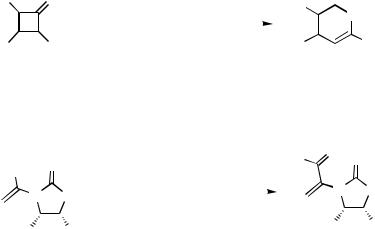
682 |
III Pd-CATALYZED CROSS-COUPLING |
|
|
|
|
|
|
|
|
|
|
|||||
|
Et |
O |
|
|
|
|
|
|
|
|
O |
|
|
|||
|
1. PhCH2PdCl(PPh3)2 cat. |
Et |
|
|
|
|
|
|
||||||||
|
|
|
|
|
|
|
|
O |
|
|||||||
|
|
|
|
|
|
|
|
|
|
|||||||
|
|
|
+ Bu3Sn-R |
|
|
|
|
|
|
|
|
|
|
|
|
|
|
|
|
|
45 psi CO, dioxane |
Et |
|
|
|
|
|
R |
|||||
|
Et |
Cl |
|
|
|
|
|
|
|
|||||||
|
|
2. 50−100 °C |
|
|
|
|
|
|
|
|
||||||
|
|
|
|
R = 2-furyl, 2-thienyl, |
|
60−80% |
|
|||||||||
|
|
|
|
|
|
|
|
|
|
|
||||||
|
|
|
|
|
|
2-ethoxyvinyl |
|
|
|
|
|
|
|
|||
|
|
|
|
|
|
Scheme 21 |
|
|
|
|
|
|
|
|
|
|
|
|
|
O |
|
|
|
|
|
|
R |
|
O |
O |
|
||
|
Me3Sn |
|
|
|
|
|
|
|
|
|
|
|
||||
|
|
|
|
|
|
|
|
|
|
|
|
|
|
|||
|
|
|
|
PdCl(Bu)(PPh3)2 cat. |
|
|
|
|
|
|
|
|||||
|
|
|
|
+ RCOCl |
|
|
|
N |
|
O |
||||||
|
|
N |
O |
|
|
|
|
|
|
|
|
|||||
|
|
PhH, 90 |
°C, CO |
|
|
|
|
|||||||||
|
|
|
|
|
|
|
|
|
|
|
|
|
||||
|
Ph |
Ph |
|
R = Ph, t-Bu, c-hexyl, Et, Me |
|
|
Ph |
|
Ph |
|||||||
|
|
|
|
|
|
|
|
|
|
|
|
|
|
|||
|
|
|
|
|
|
|
|
|
|
|
|
52−69% |
||||
Scheme 22
I. ORGANOZINC COMPOUNDS
Burton, Davis, and Heinze have reported the [Pd(PPh3)4]-catalyzed cross-coupling reaction of aromatic iodides with (E )-1,2-difluoroethylenylzinc chloride in DMF to form , - difluorostyrenes in good yields and in a stereoselective manner.[122],[123] Gillet and coworkers have reported the [Pd(PPh3)4]-catalyzed cross-coupling reaction of fluorovinylzinc reagents with acid chlorides, ethyl chloroacetate, or alkenyl iodides to form fluorovinyl ketones, esters, and heterocycles in good yields (Scheme 23).[124] A general method for the preparation of 2-(2-pyridyl)indoles based on the [Pd(PPh3)4]- catalyzed cross-coupling reaction of 1-(benzenesulfonyl)-2-indolyzinc chloride with 2-halopyridines has been reported.[125] This method has been used in the preparation of the indolo[2,3-a]quinolizidine ring system of a large number of indole alkaloids.[126] 2 - Deoxyuridines with a five-membered heterocyclic substituent at the 5-position were synthesized by [Pd(PPh3)4]-catalyzed coupling reactions of 5-iodo-2 -deoxyuridines with activated heteroaromatics (Scheme 24).[55] Alkenylzinc containing -alkoxy or - alkylthio substituents react readily with aryl or alkenyl halides in the presence of a Pd catalyst to produce arylated alkenes or conjugated dienes, respectively, with high ( 98%) stereoselectivities.[2],[127]–[130] 2-Furylzinc chloride could couple with alkenyl triflates in the presence of Pd(PPh3)4 catalyst to form 2-vinylfurans.[131] Hyuga and co-workers have reported a one-pot synthesis of prostaglandin B1 methyl ester by a stepwise Pd-catalyzed cross-coupling reaction of (E )-(2-bromoethenyl)diisopropoxyborane with -methoxy- alkenylzinc chloride followed by addition and elimination of 3-bromocyclopentenone derivatives.[132] Luo and co-workers have reported a one-pot conversion of terminal alkynes into gem-disubstituted alkenes via the addition of in situ generated hydrogen iodide and Pd-catalyzed cross-coupling with organozinc reagents including 2-furyl- and 2-thienylzinc chloride.[133],[134] Luo, Wang, and Chov have reported the tandem cyclization and cross-coupling reaction of acetylenic aryl iodides with 2-heteroarylzinc chloride to
